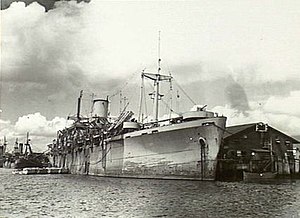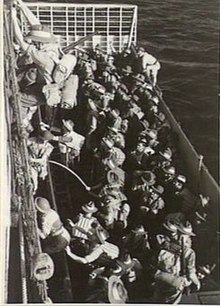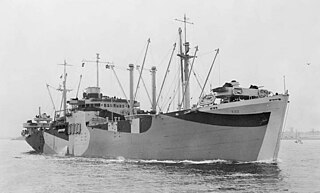
Type C1 was a designation for cargo ships built for the United States Maritime Commission before and during World War II. Total production was 493 ships built from 1940 to 1945. The first C1 types were the smallest of the three original Maritime Commission designs, meant for shorter routes where high speed and capacity were less important. Only a handful were delivered prior to Pearl Harbor. But many C1-A and C1-B ships were already in the works and were delivered during 1942. Many were converted to military purposes including troop transports during the war.

Empire Battleaxe was a British ship of the Second World War and as HMS Donovan in service with the Royal Navy just after the Second World War. Built as a Type C1-S-AY1 Landing Ship, Infantry named Cape Berkeley she then saw merchant service as Empire Battleaxe before being commissioned into the Royal Navy as HMS Empire Battleaxe and then Donovan. After she was decommissioned she returned to merchant service as Empire Battleaxe and was returned to the USA where she was renamed Cape Berkeley once again. A proposed sale in 1948 to China and renaming to Hai C fell through and she was scrapped in 1966.
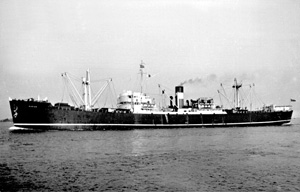
SS Empire Galahad was a refrigerated cargo ship built in 1942 and scrapped in 1967. She was also called SS Celtic Star (1946), SS Murillo (1946–52), SS Bogliasco (1952–54), MV Bogliasco (1954–63) and MV Ocean Peace (1963–67). She was built as a steamship, but in 1954 she was converted into a motor ship. She was scrapped in Taiwan in 1967.

HMS Sainfoin was a landing ship, infantry of the Royal Navy that was built in 1943 by Consolidated Steel Corporation, Wilmington, California, United States as the merchant vessel Cape Washington. She was transferred to the Ministry of War Transport in 1944 and renamed Empire Crossbow. Later that year, she was requisitioned by the Royal Navy and commissioned as HMS Sainfoin, with the pennant number F183. In 1946, she was returned to merchant service as Empire Crossbow. She was transferred to the United States in 1947 and renamed Cape Washington. The ship was then laid up until scrapped in 1964.
HMS Sansovino was an infantry landing ship in service with the Royal Navy during the late stages of the Second World War.
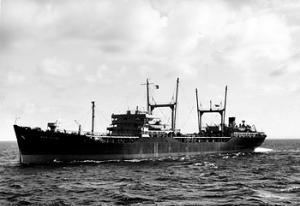
RFA Wave Victor (A220) was an 8,187 GRT Wave-class fleet support tanker of the Royal Fleet Auxiliary built at Haverton Hill-on-Tees by Furness Shipbuilding Company. She was built in 1942 as Empire Bounty for the Ministry of War Transport (MoWT). She was transferred to the Royal Fleet Auxiliary in 1946 and renamed Wave Victor with Pennant number X130. Her pennant number was later changed to A220. She served until scrapped in 1981.
Beaverburn was a 9,875 GRT fast cargo liner which was built in 1944 for Britain's Ministry of War Transport (MoWT) as Empire Captain. In 1946 she was sold to Canada and renamed Beaverburn. In 1960, she was sold back to Britain and renamed Bennachie. In 1964, she was sold to Liberia and renamed Silvana. She served until 1971 when she was scrapped.
Empire Carpenter was a 7,025 GRT cargo ship which was built in 1942 for the Ministry of War Transport (MoWT). In 1944 she was leased to the Soviet Union and renamed Dickson. In 1946, she was returned to the United Kingdom and regained her former name of Empire Carpenter. She was sold in 1947 and renamed Petfrano. In 1955, she was sold to Panama owners and renamed Amipa, further sales saw her renamed Apex. In 1968, she was sold to Cypriot owners and renamed Afros, serving until scrapped in 1971.
Nelson Star was a 7,365 GRT refrigerated cargo liner that was built in 1942 for the Ministry of War Transport (MoWT). In 1946 she was sold to Blue Star Line and renamed Gothic Star. She was renamed Nelson Star in 1948 and Patagonia Star in 1958. In 1961, she was sold and renamed Eirini. In 1970, she was sold to Cypriot owners and renamed Byzantium. After engine damage and a fire while laid up, she was scrapped in 1971.
SS Empire Chamois was a 5,864 GRT cargo ship which was built in 1918 by Ames Shipbuilding and Drydock Co, Seattle. She was ordered by the Compagnie Générale Transatlantique but was requisitioned by the United States Navy and commissioned as USS West Mount with the pennant number ID-3202 in 1918. She was decommissioned in May 1919 and passed to the United States Shipping Board (USSB) as SS Westmount. In 1927 she was sold to the Dimon Steamship Corporation and renamed SS Pacific Redwood. She returned to the USSB in 1932 and passed to the United States Maritime Commission (USMC) in 1937. In 1940, she was passed to the Ministry of Shipping, passing to the Ministry of War Transport in 1941 and being renamed SS Empire Chamois. She was sold to Astral Shipping Co Ltd in 1946 and renamed SS Granview. In 1949 she was sold to the Compagnia Maritime del Este, Panama and renamed SS Chamois, serving until 1958 when she was scrapped. She was the last Ames-built ship afloat.

Empire Lifeguard (K443) was a convoy rescue ship of the Second World War. Initially built as HMS Maiden Castle - one of 44 Castle-class corvette built for the Royal Navy - she was completed in 1944 as a convoy rescue ship to pick up survivors from attacks on the convoys. Operated for the Ministry of War Transport (MoWT) she served in this role with convoys during the war. Post war she was operated as a transport in the Mediterranean. She was damaged by a terrorist attack and sunk in 1947 but repaired and ultimately sold for scrap in 1955.
